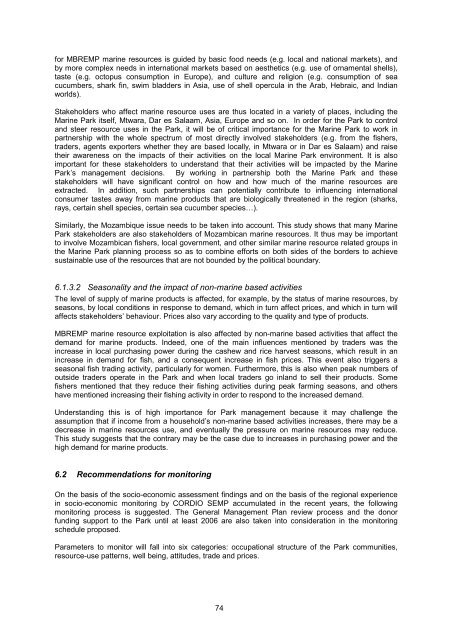a socio-economic baseline assessment of the mnazi bay - IUCN
a socio-economic baseline assessment of the mnazi bay - IUCN
a socio-economic baseline assessment of the mnazi bay - IUCN
You also want an ePaper? Increase the reach of your titles
YUMPU automatically turns print PDFs into web optimized ePapers that Google loves.
for MBREMP marine resources is guided by basic food needs (e.g. local and national markets), and<br />
by more complex needs in international markets based on aes<strong>the</strong>tics (e.g. use <strong>of</strong> ornamental shells),<br />
taste (e.g. octopus consumption in Europe), and culture and religion (e.g. consumption <strong>of</strong> sea<br />
cucumbers, shark fin, swim bladders in Asia, use <strong>of</strong> shell opercula in <strong>the</strong> Arab, Hebraic, and Indian<br />
worlds).<br />
Stakeholders who affect marine resource uses are thus located in a variety <strong>of</strong> places, including <strong>the</strong><br />
Marine Park itself, Mtwara, Dar es Salaam, Asia, Europe and so on. In order for <strong>the</strong> Park to control<br />
and steer resource uses in <strong>the</strong> Park, it will be <strong>of</strong> critical importance for <strong>the</strong> Marine Park to work in<br />
partnership with <strong>the</strong> whole spectrum <strong>of</strong> most directly involved stakeholders (e.g. from <strong>the</strong> fishers,<br />
traders, agents exporters whe<strong>the</strong>r <strong>the</strong>y are based locally, in Mtwara or in Dar es Salaam) and raise<br />
<strong>the</strong>ir awareness on <strong>the</strong> impacts <strong>of</strong> <strong>the</strong>ir activities on <strong>the</strong> local Marine Park environment. It is also<br />
important for <strong>the</strong>se stakeholders to understand that <strong>the</strong>ir activities will be impacted by <strong>the</strong> Marine<br />
Park’s management decisions. By working in partnership both <strong>the</strong> Marine Park and <strong>the</strong>se<br />
stakeholders will have significant control on how and how much <strong>of</strong> <strong>the</strong> marine resources are<br />
extracted. In addition, such partnerships can potentially contribute to influencing international<br />
consumer tastes away from marine products that are biologically threatened in <strong>the</strong> region (sharks,<br />
rays, certain shell species, certain sea cucumber species…).<br />
Similarly, <strong>the</strong> Mozambique issue needs to be taken into account. This study shows that many Marine<br />
Park stakeholders are also stakeholders <strong>of</strong> Mozambican marine resources. It thus may be important<br />
to involve Mozambican fishers, local government, and o<strong>the</strong>r similar marine resource related groups in<br />
<strong>the</strong> Marine Park planning process so as to combine efforts on both sides <strong>of</strong> <strong>the</strong> borders to achieve<br />
sustainable use <strong>of</strong> <strong>the</strong> resources that are not bounded by <strong>the</strong> political boundary.<br />
6.1.3.2 Seasonality and <strong>the</strong> impact <strong>of</strong> non-marine based activities<br />
The level <strong>of</strong> supply <strong>of</strong> marine products is affected, for example, by <strong>the</strong> status <strong>of</strong> marine resources, by<br />
seasons, by local conditions in response to demand, which in turn affect prices, and which in turn will<br />
affects stakeholders’ behaviour. Prices also vary according to <strong>the</strong> quality and type <strong>of</strong> products.<br />
MBREMP marine resource exploitation is also affected by non-marine based activities that affect <strong>the</strong><br />
demand for marine products. Indeed, one <strong>of</strong> <strong>the</strong> main influences mentioned by traders was <strong>the</strong><br />
increase in local purchasing power during <strong>the</strong> cashew and rice harvest seasons, which result in an<br />
increase in demand for fish, and a consequent increase in fish prices. This event also triggers a<br />
seasonal fish trading activity, particularly for women. Fur<strong>the</strong>rmore, this is also when peak numbers <strong>of</strong><br />
outside traders operate in <strong>the</strong> Park and when local traders go inland to sell <strong>the</strong>ir products. Some<br />
fishers mentioned that <strong>the</strong>y reduce <strong>the</strong>ir fishing activities during peak farming seasons, and o<strong>the</strong>rs<br />
have mentioned increasing <strong>the</strong>ir fishing activity in order to respond to <strong>the</strong> increased demand.<br />
Understanding this is <strong>of</strong> high importance for Park management because it may challenge <strong>the</strong><br />
assumption that if income from a household’s non-marine based activities increases, <strong>the</strong>re may be a<br />
decrease in marine resources use, and eventually <strong>the</strong> pressure on marine resources may reduce.<br />
This study suggests that <strong>the</strong> contrary may be <strong>the</strong> case due to increases in purchasing power and <strong>the</strong><br />
high demand for marine products.<br />
6.2 Recommendations for monitoring<br />
On <strong>the</strong> basis <strong>of</strong> <strong>the</strong> <strong>socio</strong>-<strong>economic</strong> <strong>assessment</strong> findings and on <strong>the</strong> basis <strong>of</strong> <strong>the</strong> regional experience<br />
in <strong>socio</strong>-<strong>economic</strong> monitoring by CORDIO SEMP accumulated in <strong>the</strong> recent years, <strong>the</strong> following<br />
monitoring process is suggested. The General Management Plan review process and <strong>the</strong> donor<br />
funding support to <strong>the</strong> Park until at least 2006 are also taken into consideration in <strong>the</strong> monitoring<br />
schedule proposed.<br />
Parameters to monitor will fall into six categories: occupational structure <strong>of</strong> <strong>the</strong> Park communities,<br />
resource-use patterns, well being, attitudes, trade and prices.<br />
74
















